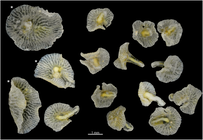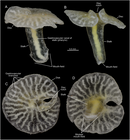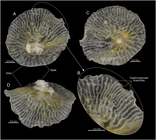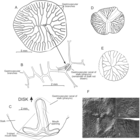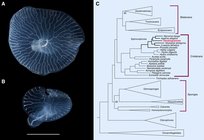WoRMS taxon details
Dendrogramma Just, Kristensen & Olesen, 2014
816793 (urn:lsid:marinespecies.org:taxname:816793)
accepted
Genus
Dendrogramma enigmatica Just, Kristensen & Olesen, 2014 (type by original designation)
- Species Dendrogramma enigmatica Just, Kristensen & Olesen, 2014
- Species Dendrogramma discoides Just, Kristensen & Olesen, 2014 accepted as Dendrogramma enigmatica Just, Kristensen & Olesen, 2014 (subjective synonym)
marine, brackish, fresh, terrestrial
recent only
Just, Jean; Kristensen, Reinhardt Møbjerg; Olesen, Jørgen. (2014). Dendrogramma, New Genus, with Two New Non-Bilaterian Species from the Marine Bathyal of Southeastern Australia (Animalia, Metazoa incertae sedis) – with Similarities to Some Medusoids from the Precambrian Ediacara. <i>PLoS ONE</i>. 9(9): e102976., available online at https://doi.org/10.1371/journal.pone.0102976 [details]
Type locality contained in Bass Strait
type locality contained in Bass Strait [details]
Etymology Dendrogramma "alludes to the branching pattern of the gastrovascular system of the disc". Greek 'dendron' tree and 'gramma'...
Etymology Dendrogramma "alludes to the branching pattern of the gastrovascular system of the disc". Greek 'dendron' tree and 'gramma' picture. The authors do not mention 'dendrogram' as in computational biology but a derivation inspired from that source has been assumed by some. [details]
Schuchert, P. (2024). World Hydrozoa Database. Dendrogramma Just, Kristensen & Olesen, 2014. Accessed through: World Register of Marine Species at: https://www.marinespecies.org/aphia.php?p=taxdetails&id=816793 on 2024-11-08
![]() The webpage text is licensed under a Creative Commons Attribution 4.0 License
The webpage text is licensed under a Creative Commons Attribution 4.0 License
original description
Just, Jean; Kristensen, Reinhardt Møbjerg; Olesen, Jørgen. (2014). Dendrogramma, New Genus, with Two New Non-Bilaterian Species from the Marine Bathyal of Southeastern Australia (Animalia, Metazoa incertae sedis) – with Similarities to Some Medusoids from the Precambrian Ediacara. <i>PLoS ONE</i>. 9(9): e102976., available online at https://doi.org/10.1371/journal.pone.0102976 [details]
additional source Hissmann, K. (2005). In situ observations on benthic siphonophores (Physonectae: Rhodaliidae) and descriptions of three new species from Indonesia and South Africa. <em>Systematics and Biodiversity.</em> 2(3): 223-249., available online at https://doi.org/10.1017/s1477200004001513
note: Arancialia has bracts which appear similar to Dendrogramma (fide O'Hara et al 2016) [details] Available for editors [request]
[request]
redescription O'Hara, Timothy D.; Hugall, Andrew F.; MacIntosh, Hugh; Naughton, Kate M.; Williams, Alan; Moussalli, Adnan. (2016). Dendrogramma is a siphonophore. <em>Current Biology.</em> 26(11): R457-R458., available online at https://doi.org/10.1016/j.cub.2016.04.051
note: molecular data places as family Rhodaliidae in Hydrozoa, Cnidaria [details] Available for editors [request]
[request]
additional source Hissmann, K. (2005). In situ observations on benthic siphonophores (Physonectae: Rhodaliidae) and descriptions of three new species from Indonesia and South Africa. <em>Systematics and Biodiversity.</em> 2(3): 223-249., available online at https://doi.org/10.1017/s1477200004001513
note: Arancialia has bracts which appear similar to Dendrogramma (fide O'Hara et al 2016) [details] Available for editors
redescription O'Hara, Timothy D.; Hugall, Andrew F.; MacIntosh, Hugh; Naughton, Kate M.; Williams, Alan; Moussalli, Adnan. (2016). Dendrogramma is a siphonophore. <em>Current Biology.</em> 26(11): R457-R458., available online at https://doi.org/10.1016/j.cub.2016.04.051
note: molecular data places as family Rhodaliidae in Hydrozoa, Cnidaria [details] Available for editors
 Present
Present  Inaccurate
Inaccurate  Introduced: alien
Introduced: alien  Containing type locality
Containing type locality
From editor or global species database
Classification Dendrogrammma, with currently one valid species, D. enigmatica, is most probably a detached part (a bract) of a benthic siphonophore. Although it is possible the bracts are from a previously described genus and species, the branching pattern of the bracteal canal, on the distal disc only, differs from that of all other rhodaliid bracts so far known. O'Hara et al (2016 supplement) show somewhat similar-bracts from a species of Arancialia; they also show an image of a preserved, but damaged, corm from which the bracts likely originated in the Supplemental InformationOriginal classification Just et al 2014: "In summary, the available information about Dendrogramma does not allow for a more precise phylogenetic position than being before the Bilateria, possibly on either the lineage leading to the Ctenophora and/or Cnidaria." "Dendrogramma shares a number of similarities in general body organisation with the two phyla, Ctenophora and Cnidaria, but cannot be placed inside any of these as they are recognised currently. We can state with considerable certainty that the organisms do not possess cnidocytes, tentacles, marginal pore openings for the radiating canals, ring canal, sense organs in the form of e.g., statocysts or the rhopalia of Scyphozoa and Cubozoa, or colloblasts, ctenes, or an apical organ as seen in Ctenophora. No cilia have been located. We have not found evidence that the specimens may represent torn-off parts of colonial Siphonophora (e.g., gastrozooids). Neither have we observed any traces of gonads, which may indicate immaturity or seasonal changes. No biological information on Dendrogramma is available. To judge from their construction, both species appear unable to swim (the ‘disc’ appears inflexible in preserved specimens). With their small, simple mouth opening it would seem likely that they feed on micro-organisms, perhaps trapped by mucus from the specialised lobes surrounding the mouth opening."
Dendrogramma assigned to Siphonophora: Hydrozoa O'Hara et al (2016) "Dendrogramma is a cnidarian, specifically a benthic siphonophore in the family Rhodaliidae. Although an entire Dendrogramma colony has not been found, we hypothesise that the mushroom-like bodies are bracts, possibly used to aid buoyancy or as defensive appendages to protect feeding gastrozooids or gonads." The authors also synonymise the second species, D. discoides, into the type species, D. enigmatica [details]
Etymology Dendrogramma "alludes to the branching pattern of the gastrovascular system of the disc". Greek 'dendron' tree and 'gramma' picture. The authors do not mention 'dendrogram' as in computational biology but a derivation inspired from that source has been assumed by some. [details]
| Language | Name | |
|---|---|---|
| English | deepsea mushroom | [details] |
